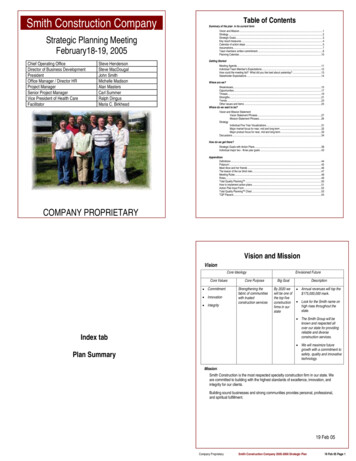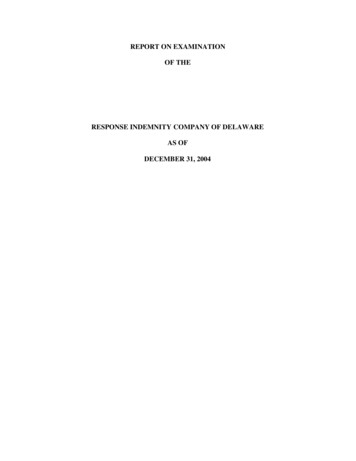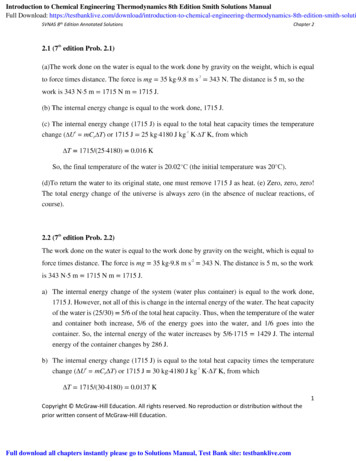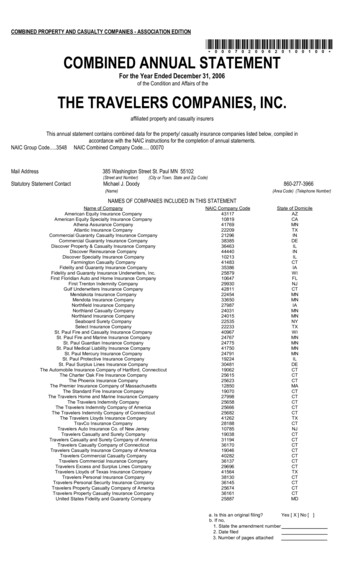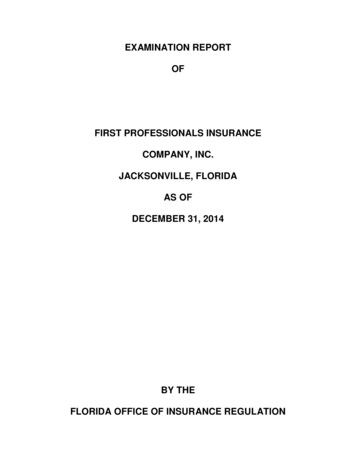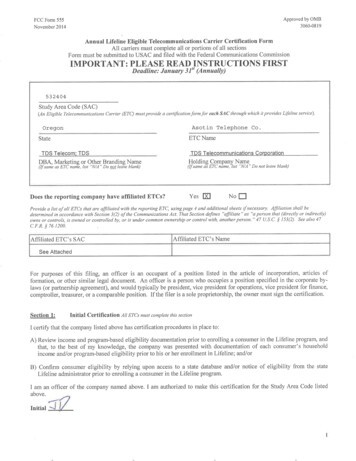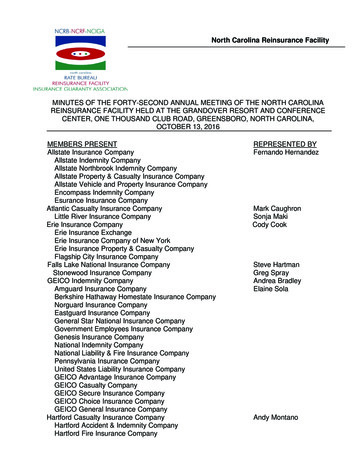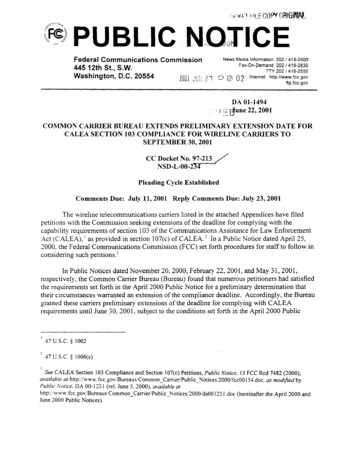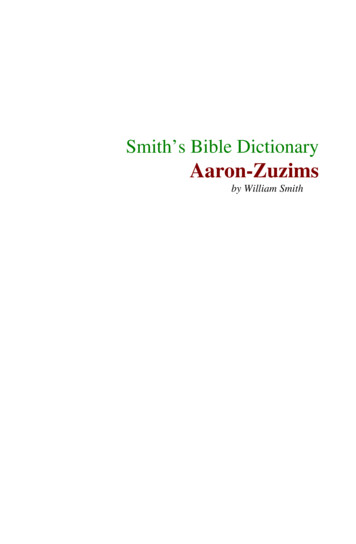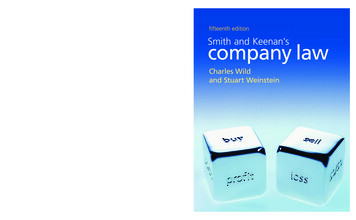
Transcription
Smith and Keenan’sThe new edition includes a number of important changes designedto aid your understanding and study of company law: Enhanced end of chapter further reading offers direction inwhere to go next to find out about a key area Further detail and context has been added throughout thecoverage of legal principles ensuring you have the necessarylevel of depth required for a full year course Chapters dealing with directors and their duties have beenrewritten to give you a clear picture of the current positionunder the 2006 Act In-depth discussion of the new model articles, along with acomparison with Table A, ensures that this is one of the mostup-to-date texts on the marketIn addition, the broad range of end of chapter questions and clearcase summaries have been retained from previous editions, ashave the additional resources in mylawchamber, offering you acompany law text with unrivalled study support in the book andonline.Your complete learning packageVisit www.mylawchamber.co.uk/keenancompany to access a wealth ofresources to support your studies andteaching.In addition access all of the self-studyresources: Practice exam questions withguidance Weblinks Legal newsfeed Answers to questions in the book Legal updates Further readingCover photograph Adam Gault/Getty Imagesfifteenth editionSmith and Keenan’scompany lawCharles Wildand Stuart WeinsteinWild and WeinsteinStuart Weinstein (JD, MBA) is Associate Head (Professional) of the Law School at the University of Hertfordshire.He teaches LLB, LLM and LPC students as well as regularly lecturing non-lawyers in the UK and on overseasprogrammes throughout the world.fifteenth editionCharles Wild (PhD, MBA, LLM) is Head of the Law School and the Centre for International Law at the University ofHertfordshire. He teaches company and international commercial law to LLB and non-law students, undertakespostgraduate research supervision and is widely published in the area.Smith and Keenan’sCombining clarity and accessibility with detailed coverage of thisoften complex subject, Smith and Keenan’s Company Law offers areadable guide to all aspects of company law. The new edition fullyincorporates the Companies Act 2006, exploring recent case lawand discussion of areas where the Act has had the most impact.company lawcompany lawwww.pearson-books.comCVR WILD1491 15 SE CVR3.indd 120/05/2011 16:53
Smith and Keenan’sCOMPANY LAW
We work with leading authors to developthe strongest educational materials in Law,bringing cutting-edge thinking and bestlearning practice to a global market.Under a range of well-known imprints, includingLongman, we craft high quality print andelectronic publications which help readers to understandand apply their content, whether studying or at work.To find out more about the complete range of ourpublishing, please visit us on the World Wide Web at:www.pearsoned.co.uk
Fifteenth EditionSmith and Keenan’sCOMPANY LAWCharles WildPhD, MBA, LLM, PCHE, LPC, CPE, BSc (Econ) MCMIHead of the School of Law at the University of HertfordshireHead of the Centre for International Law, University of HertfordshireStuart WeinsteinJD, MBA, BAAssociate Head (Professional), School of Law, University of HertfordshireSolicitor, Supreme Court of England and WalesAttorney-at-Law, New York, California, District of Columbia
Pearson Education LimitedEdinburgh GateHarlowEssex CM20 2JEEnglandand Associated Companies throughout the worldVisit us on the World Wide Web at:www.pearsoned.co.ukFirst published under the Pitman imprint in 1966Second edition published 1970Third edition published 1976Fourth edition published 1981Fifth edition published 1983Sixth edition published 1986Seventh edition published 1987Eighth edition published 1990Ninth edition published 1993Tenth edition published 1996Eleventh edition published 1999Twelfth edition published 2002Thirteenth edition published 2005Fourteenth edition published 2009Fifteenth edition published 2011 Kenneth Smith and Denis Keenan 1966Denis Keenan and Mrs K Smith 1970, 1986Denis Keenan 1987, 2005Mary Keenan, Charles Wild and Stuart Weinstein 2009Pearson Education 2011The rights of Charles Wild and Stuart Weinstein to be identified as authors of this work havebeen asserted by them in accordance with the Copyright, Designs and Patents Act 1988.All rights reserved. No part of this publication may be reproduced, stored in a retrievalsystem, or transmitted in any form or by any means, electronic, mechanical,photocopying, recording or otherwise, without either the prior written permission ofthe publisher or a licence permitting restricted copying in the United Kingdom issued bythe Copyright Licensing Agency Ltd, Saffron House, 6–10 Kirby Street, London EC1N 8TS.Crown Copyright material is reproduced with the permission of the Controller of HMSO andthe Queen’s Printer for Scotland.Law Commission Reports are reproduced under the terms of the Click-Use Licence.Pearson Education is not responsible for the content of third party internet sites.ISBN: 978-1-4082-6149-1British Library Cataloguing-in-Publication DataA catalogue record for this book is available from the British Library.Library of Congress Cataloging-in-Publication DataWild, Charles, PhD.Smith and Keenan’s company law / Charles Wild and Stuart Weinstein. – 15th ed.p. cm.ISBN 978-1-4082-6149-1 (pbk.)1. Corporation law–England. 2. Corporation law–Wales. I. Weinstein, Stuart. II. Title.III. Title: Company law.KD2079.S55 2011346.42′066–dc22201100763210 9 8 7 6 5 4 3 2 114 13 12 11Typeset in 10/12.5pt Minion by 35Printed and bound in Great Britain by Ashford Colour Press Ltd, Gosport, Hampshire
Brief contentsGuided tourPreface to the fifteenth editionLaw report abbreviationsTable of casesTable of 627The nature of a companyPromotion and incorporationThe constitution of the company – the memorandum of associationThe constitution of the company – the articles of associationThe constitution of the company – altering the articlesThe company and its contractsThe capital of a companyCapital maintenance – generallyCapital maintenance – company distributionsCompany flotationsShares – generallyShares – transfer and transmissionShares – payment for and insider dealingMembership – capacity, registration, director andsubstantial holdings, annual returnThe statutory derivative actionThe protection of minoritiesDirectors and management – generallyFinancial arrangements with, and fair dealing by, directorsThe duties of directorsVacation of office, disqualification and personal liabilityMeetings and resolutionsDebentures and chargesAccounts and auditAmalgamations, reconstructions and takeoversCorporate insolvency – company rescueCorporate insolvency – procedures other than rescueCorporate insolvency – winding-up in contextAnswers to test your knowledge questionsAppendix 1 – Companies (Model Articles) Regulations 2008, SI 2008/3229Appendix 2 – Companies (Tables A to F) Regulations 1985 (SI 1985/805)as amended by SI 2007/2541 and SI 53577592616618664682v
ContentsGuided tourPreface to the fifteenth editionLaw report abbreviationsTable of casesTable of statutes1 The nature of a companyGeneral featuresBackground to limited liabilityClassification of corporations – the company as a corporationClassification of registered companiesLifting the corporate veilCompanies and partnerships comparedThe ordinary and limited partnershipLimited liability partnerships – the ActLimited liability partnerships – the regulationsLLP or private limited company? – a checklistReform – an ordinary partnership with legal personalityAdvantages and disadvantages of incorporationCompanies and human rightsEssay questionsTest your knowledgeSuggested further reading2 Promotion and incorporationThe promoterIncorporationElectronic incorporationEffect of incorporationReady-made companiesPublicity in connection with incorporationPost-incorporation procedures for re-registrationEssay questionsTest your knowledge3 The constitution of the company – the memorandumof associationCompany namesThe objects 535455566569697071717576787983vii
ContentsCapitalThe registered officeEssay questionsTest your knowledgeSuggested further reading4 The constitution of the company – the articlesof association93The traditional division of powers under the articlesThe legal effect of the articlesThe articles and insider/outsider rightsThe effect of the Contracts (Rights of Third Parties) Act 1999Shareholders’ agreementsEssay questionsTest your knowledgeSuggested further reading96981031071081111121125 The constitution of the company – altering the articlesBreaches of contract arising out of alteration of the articlesAlteration of the articles by the courtEssay questionsSuggested further reading6 The company and its contractsPublic companies and the s 761 certificateDirectors and others as agentsEssay questionsTest your knowledge7 The capital of a companyOrdinary sharesPreference sharesVariation and abrogation of class rightsAlteration of share capitalRedeemable sharesEssay questionsTest your knowledge8 Capital maintenance – generallyReduction of capitalAcquisition of own shares – generallyPurchase of own sharesFinancial assistance for the purchase of sharesEssay questionsTest your knowledgeSuggested further 2143147147151155156158159161162171173181191192193
Contents9 Capital maintenance – company distributionsProfits available for distribution – generallyWhat is a distribution?Profits available – public and private companiesRealised profits and accounting standardsRelated statutory rulesSpecial casesRelevant accountsAudit considerationsDeclaration and payment of dividendsConsequences of unlawful distributionCapitalising profitsReservesEssay questionsAid to learning on distributions10 Company flotationsThe official system for listing securities on an investment exchangeOffers of unlisted securitiesThe remedy of rescissionProcedures for issuing sharesUnderwritingBrokerageReformEssay questionsTest your knowledge11 Shares – generallySubscribers’ contractAllotmentReturn of an allotmentShare certificatesShare warrants (or bearer shares)CallsMortgages of sharesLienForfeiture of sharesSurrender of sharesEssay questionsTest your knowledge12 Shares – transfer and transmissionTransfer of unlisted sharesTransfer of listed sharesCompanies whose articles restrict transferTransmission of 9230232233234236237239240240242243245248254255ix
ContentsEssay questionsTest your knowledge13 Shares – payment for and insider dealingThe consideration – generallyProhibition on allotment of shares at a discountShares issued at a premiumInsider dealingMarket abuseModel Code for Securities Transactions by directors oflisted companiesEssay questionsTest your knowledge14 Membership – capacity, registration, director andsubstantial holdings, annual return258259263264267269271272273275CapacityThe register of membersDirector and substantial shareholdingsThe annual returnEssay questionsTest your knowledge27627728128328528615 The statutory derivative action288The s 33 contract revisitedShareholders’ agreementsThe rule in Foss v HarbottleThe statutory derivative actionEssay questionsSuggested further reading16 The protection of minoritiesStatutory protection against unfair prejudiceMinority petition for a just and equitable winding-upEssay questionsTest your knowledgeSuggested further reading17 Directors and management – generallyDefinitionAppointment of directorsDirectors’ share qualificationDivision of power – directors and membersThe chairman and executive directorsPublicity in connection with directorsThe secretaryThe company 331333334336346346351353354356
ContentsEssay questionsTest your knowledgeSuggested further reading18 Financial arrangements with, and fair dealing by,directorsRemunerationThe power to pay directorsCompensation for loss of officeFair dealing by directorsEssay questionsTest your knowledge19 The duties of directorsThe CA 2006 codifies the general duties of directorsScope and nature of general dutiesDuty to act within powersDuty to promote the success of the companyDuty to exercise independent judgmentDuty to exercise reasonable care, skill and diligenceDuty to avoid conflicts of interestDuty not to accept benefits from third partiesDuty to declare interest in proposed transaction or arrangementEffects of a breach of dutyMinisterial ‘eight-point guidance’Essay questionsTest your knowledge20 Vacation of office, disqualification and personal liabilityExpiration of the period of officeRemoval – under statuteRemoval under the articlesStatutory removal – restrictionsResignationWinding-upAppointment of an administrator/administrative receiverDisqualification – generallyDisqualification by the court and personal liabilityDisqualification onlyDisqualification and personal liabilityPersonal liability onlyHuman rights and directorsEssay questionsTest your knowledge21 Meetings and resolutionsGeneral meetings of the companyNotice of 6417418419419424430432434436438439443xi
ContentsProcedure at meetings – legal aspectsThe chairmanVotingProxiesAdjournment of the meetingMinutesClass meetingsCompany meetings and the disabledBoard meetingsResolutions – generallyOrdinary resolutions requiring special noticeAmendmentsWritten resolutions for private companies (s 288, CA 2006 et seq.)Meetings of single-member companiesElectronic communications – CA 2006Essay questionsTest your knowledge22 Debentures and chargesPower to borrowDebentures – generallyTypes of debenturesAcquisition of debenturesThe trust deedCompany chargesCrystallisation of floating chargesPostponement of floating chargesValidity of chargesRegistration of chargesCompany’s registerAvoidance of floating chargesPreferenceRemedies of secured debenture holdersBIS consultationEssay questionsTest your knowledge23 Accounts and auditSmall and medium-sized companiesAccounting recordsAnnual accountsGroup accountsThe directors’ reportPublication of accounts and reportsFiling of accounts and reportsAuditorsDuties of auditorsRights of 6498499499500501503504506507510511513514516519519
ContentsInformation and the Companies (Audit, Investigations and CommunityEnterprise) Act 2004Duty of care of the auditorAuditors’ liabilityEssay questionsTest your knowledge24 Amalgamations, reconstructions and takeoversGenerallyAmalgamations and reconstructionsAmalgamation (or reconstruction) under the Insolvency Act 1986, s 110Amalgamation (or reconstruction) under the CA 2006, s 895TakeoversEssay questionsTest your knowledge25 Corporate insolvency – company rescueVoluntary arrangementsAdministrationEssay questionsTest your knowledge26 Corporate insolvency – procedures other than rescueReceivershipsWinding-up or striking offCompulsory winding-upVoluntary winding-upMembers’ voluntary winding-upCreditors’ voluntary winding-upAlternatives to winding-up27 Corporate insolvency – winding-up in contextWinding-up by the courtVoluntary winding-upThe duties of a liquidatorCompulsory winding-up by a company in voluntary liquidationEssay questionsTest your knowledgeAnswers to test your knowledge questionsAppendix 1 – Companies (Model Articles) Regulations 2008, SI 2008/3229Appendix 2 – Companies (Tables A to F) Regulations 1985 (SI 1985/805)as amended by SI 2007/2541 and SI 9601612612614616618664682xiii
Your complete learning packageVisit www.mylawchamber.co.uk/keenancompany to access a wealth of resourcesto support your studies and teaching.Self study resources Practice exam questions with guidance to hone your exam techniqueWeblinks to help you read more widely around the subject and really impressyour lecturersLegal newsfeed to help you read more widely, stay right up to date with the lawand impress examinersAnswers to questions in the book to compare with your own responsesLegal updates to help you stay up to date with the law and impress examinersFurther reading to help you read more widely around the subject and impress yourlecturersAlso: The regularly maintained mylawchamber site provides the following features: Search tool to help locate specific items of content. Online help and support to assist with website usage and troubleshooting.xiv
Guided tourTopic maps – at the start of eachchapter topic maps are used toillustrate complex legal structures andprocesses.Marginal cross references – Clearin-text cross-references come inhandy to help you identify where todiscover more information on keytopics.See p. 162See p. 334(g) As regards distribution of profits and assets. Where interim accounts are used tproposed distribution these accounts must, in the case of a public company, bthe Registrar of Companies, whereas there is no filing requirement for privatePrivate companies need only fulfil the basic requirement of profits available ftion. Public companies must also comply with the capital maintenance ruprivate companies need not (see further Chapters 8 and 9 ).(h) As regards loans to directors, etc. Quasi-loans and credit transactions, etc. for dithe directors of the company’s holding company are prohibited with certainin the case of public companies, as are loans, etc. to persons connected with thand the directors of any holding company. Quasi-loans and credit are not so rprivate companies nor are, in general, such dealings with connected personsChapter 17 ).(i) An essential feature of more recent company legislation has been the move tderegulation of private companies. In particular, company legislation now pwritten resolutions of private companies which can be passed by members wneed to call or hold a meeting. Private companies may also opt out of the aument. These matters are considered in more detail in appropriate parts of theLa Société Anonyme des Anciens Etablissements Panhard et Lavassor vPanhard Levassor Motor Co Ltd [1901] 2 Ch 513In this case, which we can call the Panhard case, the claimant was a French company and itwere sold in England. The French company wished to set up an English company to actagent in England to improve the sales of its cars there. To try to stop this the defendant Ecompany was registered, its promoters hoping that the French company would not be aregister its name for its English corporate agent, there being a company of ‘too like’ name oregister already, and that this would prevent increased competition in the car market. It wasthat the members of the English company must change the name of their company or windor the company would be taken off the register.xviCase summaries – throughout thechapters essential case summariesdetail key decisions in companylaw clearly explaining the decision.
Guided tourEssay questions1 ‘There are occasions when the courts will look behind the formality of legal personality and wiappear to disregard it, but it is impossible to find any consistent principle upon which they wido so.’Discuss.(Kingston University2 In 2005 Archie, Bert, Colin and David, as shareholders and directors, set up a company toacquire a disused mill to renovate into single-person flats. David had bought the mill in 2004and sold it to the company once it was formed. Bert has now become concerned that this deahas caused the company to suffer a loss. Advise Bert on what the common law position isregarding the company, the transaction and the protection of his interests.(University of the West of ScotlandEssay questions – end of chapteressay questions allow you to honeyour essay writing skills while askingyou to reflect on and consider whatyou have learnt from the chapter.Answer guidance may be foundon the website.3 Eric and Stanley have been carrying on business in partnership as building contractors in aTest your knowledgeFour alternative answers are given. Select ONE only. Circle the answer which you consider to bcorrect. Check your answers by referring back to the information given in the chapter and againsthe answers at the back of the book.1 When a private company wants to re-register as a public company it must file a balance sheewith the Registrar. The balance sheet must be one which is not more than:Test your knowledge – end ofchapter test your knowledge sectionschallenge you to check that youunderstand each topic fully. Answerscan be found at the back of the book.Fifteen months old at the date of re-registration.Seven months old at the date of re-registration.Fifteen months old at the date of application.D Seven months old at the date of application.ABC2 Thames was re-registered from a limited to an unlimited company. It wishes to re-register asYour complete learning packageVisit www.mylawchamber.co.uk/keenancompany to access a wealth ofresources to support your studies: Practice exam questions withguidance to hone your examtechniqueWeblinks to help you read morewidely around the subject and reallyimpress your lecturersLegal newsfeed to help you readmore widely, stay right up to datewith the law and impress examinersAnswers to questions in the book tocompare with your own responsesLegal updates to help you stay up todate with the law and impressexaminersFurther reading to help you readmore widely around the subject andimpress your lecturersxvii
Preface to the fifteenth editionThe major feature of this edition has been the continued exploration and analysis of theimpact of the Companies Act 2006. The introduction of the 2006 Act has, quite literally, represented a ‘wholesale rethink’ of modern company law and, as such, had a significant impacton every aspect of the subject area. While this represents an exciting and challenging periodfor practitioners, academics and students alike, it has nonetheless meant that our considerable reworking of the fourteenth edition has been continued in order to keep pace with thechanges brought about by the new Act.By now the majority of readers will be sufficiently familiar with the new section numbering of the 2006 Act or, as in the case of the majority of students, will be approaching this areafor the first time since continued references to the 1985 Act have become redundant.Consequently, details of the Companies Act 1985 have either been removed entirely or, inspecific chapters, been retained only where a comparison with the previous wording is absolutely necessary.In addition, we have sought to continue our analysis of the fundamental change inapproach to corporate regulation at the small and medium-sized company level, which theCompanies Act 2006 has represented. This has not only impacted on the chapters dealingwith shares and the capital of companies but also the internal management and operations ofcompanies. In this regard, the new Model Articles that accompany the 2006 Act, and whichhave replaced Table A as the template for corporate constitutions from 1 October 2009, represent a dramatic shift away from the ‘one size fits all’ mentality to that of a ‘think small first’approach, providing bespoke model articles for private companies limited by shares, privatecompanies limited by guarantee, and public companies limited by shares. However, Table Aremains an important consideration when dealing with any company incorporated beforethis date. Consequently, we have sought to introduce the new Model Articles, together withtheir impact on the day-to-day management and running of both public and private companies while, at the same time, maintaining a thorough analysis of Table A with respect to acompany’s constitution. Given the complexity of this issue, the natural overlap between thevarious Model Articles, as well as the obvious need to compare and contrast Table A with thenew Model Articles, we have inserted Appendices which contain copies of these documents.Readers are referred to them throughout the text to help them to familarise themselves withthese key provisions.We have continued to expand and enrich reference to case law throughout. This includescurrent cases relating to the new statutory derivative action and the unfair prejudice head, aswell as a broader analysis of traditional common law and equitable duties imposed on directors, which underpin the statutory duties introduced by the 2006 Act. As with the previousedition, this is supported by reference to an increased selection of academic articles at the endof certain chapters, in order to ensure that the text is as current and relevant as possible forreaders.Finally, this edition includes an extended analysis of the constitution of a company, in thelight of the new Model Articles, as well as a significant reworking of the section dealing withxviii
Preface to the fifteenth editiondirectors’ duties and management of the company. We have also reworked the chapter focusing on meetings and resolutions so as to set down a comprehensive, yet easily accessible,account of the procedures and processes introduced by the Companies Act 2006 and whichare at the heart of this subject area. In addition, the chapters on minority protection and thestatutory derivative action have been reworked to provide the reader with greater detail andinsight into the processes involved as well as current case law.We would like to thank those members of staff at Pearson Education who have helped toproduce this edition, particularly Zoe Botterill, Acquisitions Editor – Law, and GabriellaPlayford. We would also like to thank Mary Keenan for her continued support with the ongoing development of this book. Our thanks are also due to those who designed, set, printed andbound the book.We would also like to thank our respective families who have shown considerable patienceand understanding over the past few months. The production of any text requires a significantsupport network and for that we are both truly grateful.Any errors and omissions at the level at which the text is aimed are down to the authors.Charles Wild and Stuart WeinsteinSt Albans, March 2011xix
Law report abbreviationsThe following table sets out the abbreviations used when citing the various series of certainlaw reports which are in common use, together with the periods over which they extend.ACATCAll ERAll ER (D)All ER RepApp CasBCCBCLCB & CRCLCLJCLYCMLRChCom CasFamICRIRLBIRLRITRKBLGRLloyd LR or(from 1951)Lloyd’s RepLRRPLSGNLJPP & CRPIQRQBSJSTCTax Cas(or TC)TLRWLRxxLaw Reports, Appeal Cases, 1891–(current)Annotated Tax Cases, 1922–75All England Law Reports, 1936–(current)All England Direct (an online service)All England Law Reports Reprint, 36 vols 1558–1935Law Reports, Appeal Cases, 15 vols 1875–90British Company Law and Practice (CCH editions)–(current)Butterworths Company Law Cases, 1983–(current)Reports of Bankruptcy and Companies Winding-up Cases, 1918–(current)Current Law Monthly Digest, 1947–(current)Cambridge Law JournalCurrent Law Yearbook, 1947–(current)Common Market Law Reports, 1962–(current)Law Reports Chancery Division, 1891–(current)Commercial Cases, 1895–1941Law Reports Family Division, 1972–(current)Industrial Court Reports, 1972–74; Industrial Cases Reports, 1974–(current)Industrial Relations Law Bulletin, 1993–(current)Industrial Relations Law Reports, 1971–(current)Reports of decisions of the Industrial Tribunals, 1966–(current)Law Reports, King’s Bench Division, 1901–52Local Government Reports, 1902–(current)Lloyd’s List Law Reports, 1919–(current)Law Reports Restrictive Practices, 1957–(current)Law Society Gazette ReportsNew Law JournalLaw Reports, Probate, Divorce and Admiralty Division, 1891–1971Planning and Compensation Reports, 1949–(current)Personal Injuries and Quantum ReportsLaw Reports Queen’s Bench Division, 1891–1901; 1953–(current)Solicitors’ Journal, 1856–(current)Simon’s Tax Cases, 1973–(current)Tax Cases, 1875–(current)Times Law Reports, 1884–1952Weekly Law Reports, 1953–(current)
Table of casesA & BC Chewing Gum Ltd, re [1975] 1 AllER 1017 338ABC Coupler & Engineering Ltd, re [1961]1 All ER 354 595ASRS Establishment Ltd, re (1999) TheTimes, 17 November 484Abbott v Strong (1998) The Times, 9 July524Accidental Death Insurance Co, Allin’s Case,re (1873) LR 16 Eq 449 251Adair v Old Bushmills Distillery [1908] WN24 148Adams v Cape Industries [1990] Ch 433, CA1, 13, 30Adelaide Electric Co v Prudential Assurance[1934] AC 122, HL 151Advantage Healthcare (T10) Ltd, re [1999]All ER (D) 1294 494Aerators Ltd v Tollitt [1902] 2 Ch 319 81Agnew v Inland Revenue (The BrumarkCase) [2001] All ER (D) 21 485, 486Airey v Cordell [2006] EWHC 2728 (Ch)303Al Saudi Banque v Clarke Pixley [1989] 3 AllER 361 524Albacruz (Cargo Owners) v Albazero(Owners), The Albazero [1977] AC 77431Alexander v Automatic Telephone Co[1900] 2 Ch 56 234Allen v Gold Reefs of West Africa Ltd [1900]1 Ch 656 114–117, 120, 146Allen v Hyatt (1914) 30 TLR 444 386Allied Carpets Group plc v Nethercott[2001] BCC 81 205Allin’s Case see Accidental Death InsuranceCo, Allin’s Case, reAl-Nakib Investments (Jersey) Ltd vLongcroft [1990] 3 All ER 321 217Aluminium Industrie Vaassen BV vRomalpa Aluminium [1976] 2 All ER 552489, 490American Cyanamid Co v Ethicon [1975]AC 396 490Andrews v Gas Metre Co [1897] 1 Ch 361144Anglesey Colliery Co, re (1886) 1 Ch App555 594Anglo-American Insurance Ltd [2001]1 BCLC 755 536Antal International Ltd [2003] EWHC 1339(Ch), [2003] 2 BCLC 406 573Arab Bank plc v Mercantile Holdings Ltd[1994] 1 All ER 74 186Arthur Rathbone Kitchens Ltd, re [1997]2 BCLC 280 557Ashbury v Watson (1885) 30 Ch D 376 145Ashbury Railway
v Guided tour xvi Preface to the fifteenth edition xviii Law report abbreviations xx Table of cases xxi Table of statutes xxxvi 1 The nature of a company 1 2 Promotion and incorporation 55 3 The constitution of the company – the memorandum of association 78 4 The constitution of the company – the articles of associat
